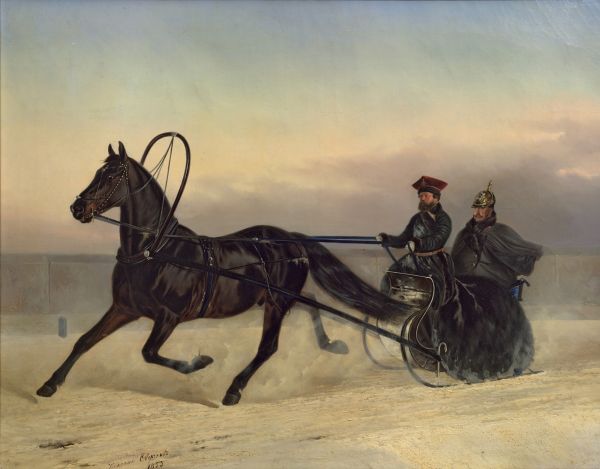|
|
Nicholas I in a Sledge. 1853

Sverchkov Nikolai
73 х 92
Пост. в 1897 из Зимнего дворца, Петербург
Annotation
Nikolai Sverchkov, the son of a court coachman and groom, dedicated his entire artistic career to equine painting and the Imperial Court, which frequently commissioned work from him. Regardless of the subject, his canvases almost always featured horses. The portraits Sverchkov painted were no exception. The artist’s models, as a rule, either were riding in horse-drawn carriages or were sitting on horses. This half-portrait/half-genre painting by Sverchkov is devoid of the usual pomp of works that depict the emperor – this case, Nicholas I – and shows him outside of an official situation, causing us to see him less as an autocrat, and more as a private person.
Emperor Nicholas I (1796–1855) was the third son of Emperor Paul I and Empress Marie Feodorovna. He ascended to the throne in 1825. The reign of Nicholas I is characterised by the centralisation of government and regulation in all areas of activity. In 1826, he created the Third Section of His Imperial Majesty’s Own Chancellery, which was tasked with monitoring the political reliability of subjects, and in 1827, he published a new censorship decree, which was called “cast iron” by his contemporaries. The foundation of his domestic policies was the principle of “autocracy, orthodoxy and nationality”. The sanctity of the autocracy also formed the basis for his foreign policy. In 1833, an agreement was reached between Russia, Austria and Prussia on reciprocal support in the case of a political crisis. This agreement is what led Nicholas I to send troops to help suppress the Hungarian Uprising (1848–1849). His assumption of the role of protector of Christian peoples under Muslim rule determined the direction of his Eastern foreign policy. The Russo-Turkish War (1828–1829) contributed to Greece gaining its independence (1830). The last years of Nicholas I’s reign were overshadowed by setbacks in the Crimean War (1853–1856). The character and activities of the Emperor caused contradictory assessments among his contemporaries, from enthusiastic veneration (“The Knight of Autocracy”) to definitive opposition (“The Gendarme of Europe”).
Author's Biography
Sverchkov Nikolai
Sverchkov, Nikolai Egorovich (1817, St Petersburg — 1898, Tsarskoe Selo, near St. Petersburg)
Painter, draughtsman, lithographer, genre artist, portraitist, animal artist. Born into a family of a cabman. Did not receive professional artistic education. Worked for the Ministry of the Interior (until 1842). Awarded the title of free portraitist at the Imperial Academy of Arts for Rider, Self- Portrait, etc. (1839). Undertook painting commissions from Khrenov and Çesme stud farms (from 1840s). Academician for 'Landowner’s Troika' (1852), professor (1855). Awarded the Légion d’honneur at the World Exhibition in Paris (1863) for 'Return from the Bear Hunt', 'Fair in Voronezh', 'Postal Station'.

